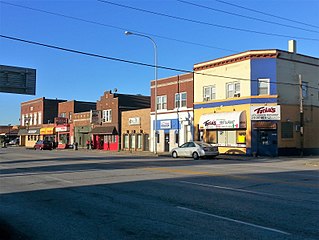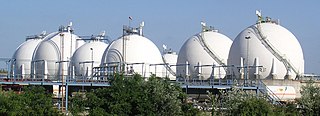
Indianapolis, often shortened to Indy, is the state capital and most populous city of the U.S. state of Indiana and the seat of Marion County. According to 2017 estimates from the U.S. Census Bureau, the consolidated population of Indianapolis and Marion County was 872,680. The "balance" population, which excludes semi-autonomous municipalities in Marion County, was 863,002. It is the 16th most populous city in the U.S. The Indianapolis metropolitan area is the 34th most populous metropolitan statistical area in the U.S., with 2,028,614 residents. Its combined statistical area ranks 27th, with a population of 2,411,086. Indianapolis covers 368 square miles (950 km2), making it the 16th largest city by land area in the U.S.
William A. Walsh was an American football player for the University of Notre Dame, an attorney, and a mayor and city judge of Yonkers, New York.

Hobart, also known as The Pennsy Depot, is a disused train station in Hobart, Indiana. It was built in 1911 and listed on the National Register of Historic Places in 1984 as the Pennsylvania Railroad Station.

Charles E. Cox was an American lawyer and judge who became the 55th justice of the Indiana Supreme Court, serving from 1911 to 1917. Elected as a Democrat in the Fall of 1910, he was Chief Justice by the end of his six-year term. The "Marshall Constitution" case and the "Technical Institute" case were among the important decisions made by the court during his tenure. As a judge in the Indiana Supreme Court and in lower courts, he never had a decision reversed.
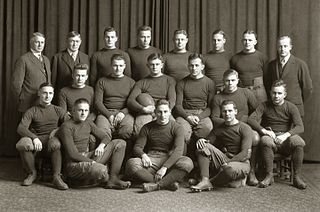
The 1915 Michigan Wolverines football team represented the University of Michigan in the 1915 college football season. The team's head coach was Fielding H. Yost. The Wolverines played their home games at Ferry Field.
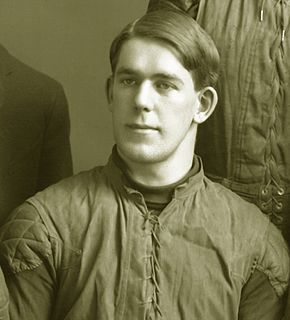
Herbert Spencer Graver, Sr. was an American football player and coach and businessman. He played at the end, halfback, fullback, and quarterback positions for Fielding H. Yost's renowned 1901, 1902 and 1903 "Point-a-Minute" football teams. He scored five touchdowns against Ohio State in 1903, which remains the single-game record for the most touchdowns scored by a player for either team in the history of the Michigan–Ohio State football rivalry. In 1904, Graver was the head coach of the Marietta College football team. He worked for the Graver Tank Company from 1904 to 1954.

James Lilly Zink was an athletic director at Indiana University and DePauw University as well as one of the first head coaches of the basketball and football teams at Butler University.
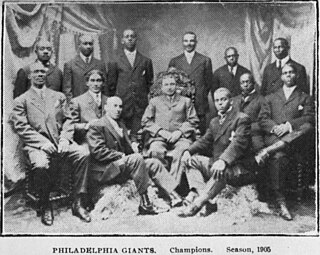
Henry William "Harry" Moore was an African-American baseball Utility player and in the pre-Negro leagues. He appears as "Harry Moore," "Henry Moore," and even "Mike Moore."
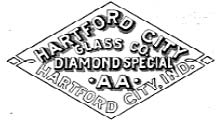
Hartford City Glass Company was among the top three window glass manufacturers in the United States between 1890 and 1899, and continued to be one of the nation's largest after its acquisition. It was also the country's largest manufacturer of chipped glass, with capacity double that of its nearest competitor. The company's works was the first of eight glass plants that existed in Hartford City, Indiana during the Indiana Gas Boom. It became the city's largest manufacturer and employer, peaking with 600 employees.

The Grand Calumet River is a 13.0-mile-long (20.9 km) river that flows primarily into Lake Michigan. Originating in Miller Beach in Gary, it flows through the cities of Gary, East Chicago and Hammond, as well as Calumet City and Burnham on the Illinois side. The majority of the river's flow drains into Lake Michigan via the Indiana Harbor and Ship Canal, sending about 1,500 cubic feet (42 m3) per second of water into the lake. A smaller part of the flow, at the river's western end, enters the Calumet River and ultimately drains into the Illinois and ultimately the Mississippi River.

Alvin Tobias Hert was the mayor of Brazil, Indiana in 1895. He was the warden of the Indiana Reformatory in Jeffersonville, Indiana in 1902. In 1902 he was named president of the American Creosoting Company. He was a committeeman representing Kentucky at the 1916 Republican National Convention.

William V. Thompson was an American professional and champion tenpin bowler. He was the proprietor of Plaza Bowling Alley in the Chicago Plaza Hotel, the first official regulation ten-pin bowling alley. He formed a bowling club from champion bowlers and challenged other organizations across the nation. Thompson was influential in forming of the ultimate sanctioned regulations rules of the game and an advocate of the original American Bowling Congress. He was general manager of the department at Brunswick-Balke-Collender Company that made the bowling equipment for the alleys.
Calumet is the portion of East Chicago, Indiana located east of the Indiana Harbor and Ship Canal and south of Chicago Avenue. The neighborhood is bisected by the Indiana Harbor Belt Railroad. The area west of the tracks is referred to as Calumet proper, or as "West Calumet". The area east of the tracks is known as "East Calumet."

